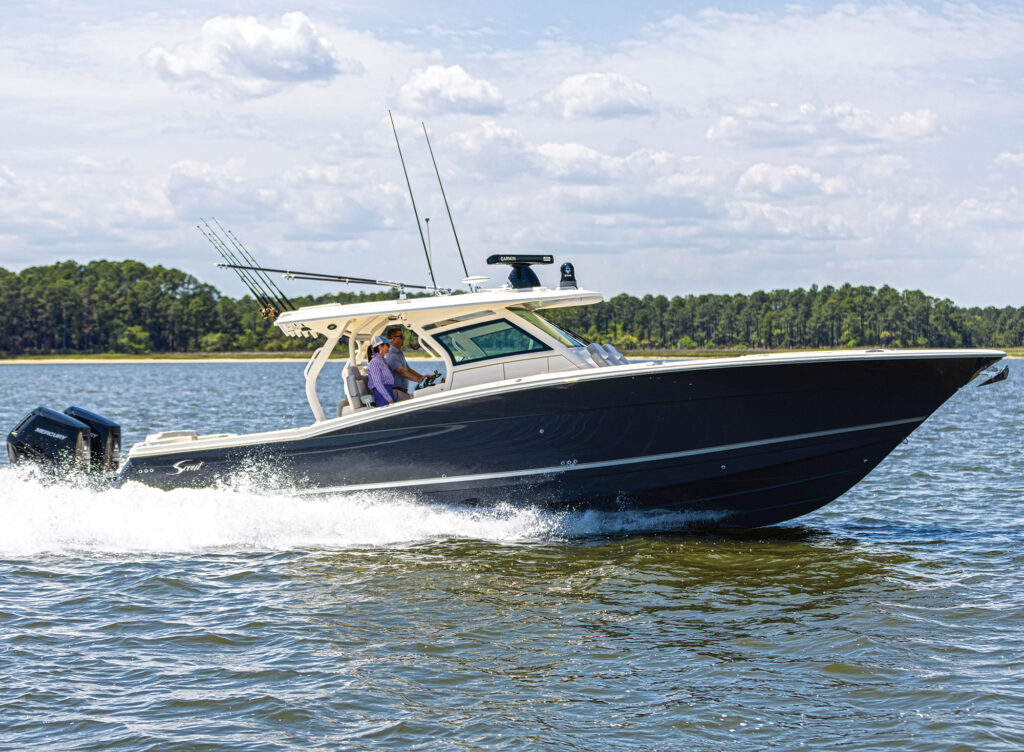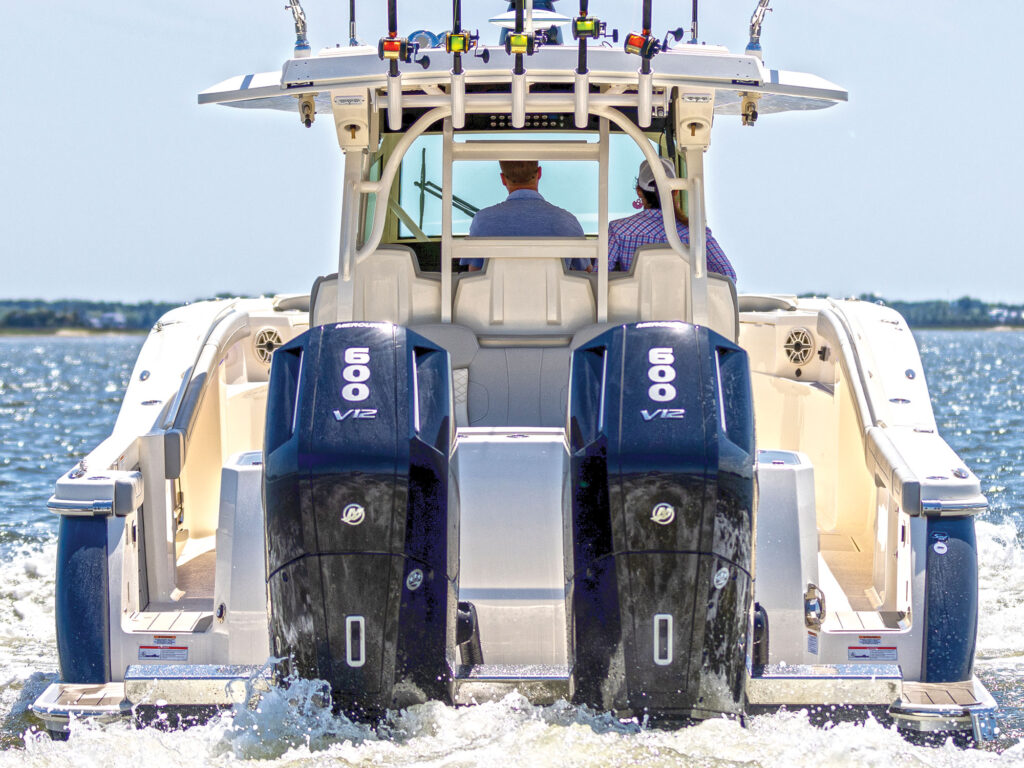SB Television
Scout 400 LXF Li-Ion Fathom E-Power System
 Fathom provides data monitoring, including consumption rate and time remaining.
Courtesy Scout Boats
Fathom provides data monitoring, including consumption rate and time remaining.
Courtesy Scout Boats
The 39-foot-7-inch Scout 400 LXF Li-Ion is a wide-beam luxury center-console equipped with the Fathom M7000-X+ Series, currently the premier e-power system offered by Navico Group, the technology division of Brunswick Corporation. Scout is one of the first boatbuilders outside the Brunswick portfolio to offer Fathom.
“We think that the 400 LXF is an ideal platform for this Fathom system,” says Scout product specialist Capt. Josh Slayton. “This model is often used for entertaining and comes standard with power-hungry features including air conditioning, a gyrostabilizer, a powerful audio system, heated seats, a galley and a water heater. A silent e-power system in place of a genset offers the level of sophistication our customers expect from a Scout S-Class model, our highest level of luxury.”
Regulator Boats is also offering an e-power system. Its E-Hub Lithium Battery System, assembled from components produced by Dometic Mobile Power Solutions, is standard equipment on the new Regulator 35 model, with three 300-amp-hour house batteries replacing a genset. The E-Hub system can be charged by shore power or by triple Yamaha F350 outboards.
 Scout is one of the first boatbuilders outside the Brunswick portfolio to offer Fathom.
Courtesy Scout Boats
Scout is one of the first boatbuilders outside the Brunswick portfolio to offer Fathom.
Courtesy Scout Boats
Silent and odor-free operation is an obvious benefit of an e-power system over a diesel genset. E-power eliminates genset maintenance—always a headache—and offers the convenience of a single liquid fuel source. Plus, genset exhaust can create a carbon monoxide safety hazard.
Scout rigs the Navico Fathom M5000 series e-power system in place of a genset on its 377 LXF model. For charging, this system relies on shore power or the 12-volt alternators of Mercury or Yamaha outboards and provides basic monitoring and control. The Fathom 7000-X+ system offers next-level technology with real-time updates on battery-bank status and power consumption presented on the boat’s MFD. The M7000-X+ series also integrates seamlessly with Mercury V-10 and V-12 Verado outboards equipped with 150-amp 12-/48-volt alternator systems, enabling precise control over the charge source and four times the charging speed of a 12-volt alternator.
The Fathom system is created using components supplied by Navico brands, including Mastervolt batteries and invertor/chargers and CZone digital switching in a complete system supplied to boatbuilders. The 400 LXF Li-Ion is equipped with four Mastervolt MLI Ultra 24/6000 lithium-iron-phosphate (LiFePO4) batteries offering 6 kW/240 Ah of power. According to Slayton, this is enough power to run a 12,000 Btu air conditioner and a Seakeeper 4.5 continuously for five hours with the engines shut down. Navico claims battery life of 3,500 charge cycles, which Scout says equates to about 10 years of typical boat use. The entire system is covered by a five-year nondeclining warranty.
Read Next: The Benefits of 48-Volt Charging in Fathom 2.0
 Specially constructed and managed lithium batteries power the Fathom system safely and efficiently.
Courtesy Scout Boats
Specially constructed and managed lithium batteries power the Fathom system safely and efficiently.
Courtesy Scout Boats
Slayton explains that the Fathom e-power system weighs about the same as the generator and other components it replaces, including a 15-gallon diesel fuel tank, and fits in the same space below an aft cockpit hatch. Engine options include triple or quad Merc Verado 400 hp V-10s or twin 600 hp Verado V-12 outboards. In all cases, two of the motors are equipped with the 12-/48-volt alternator system.
That alternator really makes this system perform. At engine speeds above 2,500 rpm, each alternator pumps out 100 net amps (6.5 kW) to the battery bank. Charge time might vary, but from indicated zero state of charge, the system will fully charge in just two hours of run time or 3.2 hours from 120-volt AC shore power.
 Mercury V-12 and V-10 outboards can be fitted with high-capacity, dual-voltage 12-/48-volt alternators to quickly recharge the Fathom system’s batteries.
Courtesy Scout Boats
Mercury V-12 and V-10 outboards can be fitted with high-capacity, dual-voltage 12-/48-volt alternators to quickly recharge the Fathom system’s batteries.
Courtesy Scout Boats
There are also two selectable high-speed idle charge modes, which can be used when the boat is not underway. Extend Mode (2,000 rpm) generates 5 kW per engine (10 kW total). This mode adds approximately 10 percent SOC every 15 minutes. Boost Mode (2,500 rpm) generates about 13 kW total, adding 10 percent SOC every 10 minutes. In either mode, the engines are electronically prevented from shifting into gear. At engine speeds below 2,000 rpm, the alternators switch to 12 volts. With Extend and Boost modes, Scout owners can remain independent at the sandbar or at anchor for a much longer period of time. Some boaters might be concerned about lithium batteries. We’ve all heard about e-bikes, e-scooters and battery-powered automobiles erupting in flames. Navico says that its Mastervolt batteries meet the ABYC E13 marine standard, are UL 1973 certified, and utilize the safest battery chemistry—that is LiFePO4—available. A built-in battery-management system monitors voltage, current, temperature, and state of charge to ensure that the battery is functioning safely, protecting the cells from overcharging or overdischarging. A safety disconnect will automatically stop charging and disconnect loads if a safety event is triggered. Anecdotally, tens of thousands of recreational fishing boats now run large LiFePO4 banks with no reported safety issues.
Sorry, but there’s no free lunch. The Navico Fathom e-power system represents a $26,000 upcharge built into the $1,138,578 base price of the Scout 400 LXF Li-Ion model, compared with a similarly equipped Scout 400 LXF model with its standard Fischer Panda 8kW diesel generator. That upcharge is about 2 percent of the boat price, which we think is a reasonable toll to pay for those seeking the technology, convenience and luxury offered by e-power.
The post Scout 400 LXF Li-Ion Fathom E-Power System appeared first on Boating Mag.
- Home
- About Us
- Write For Us / Submit Content
- Advertising And Affiliates
- Feeds And Syndication
- Contact Us
- Login
- Privacy
All Rights Reserved. Copyright , Central Coast Communications, Inc.